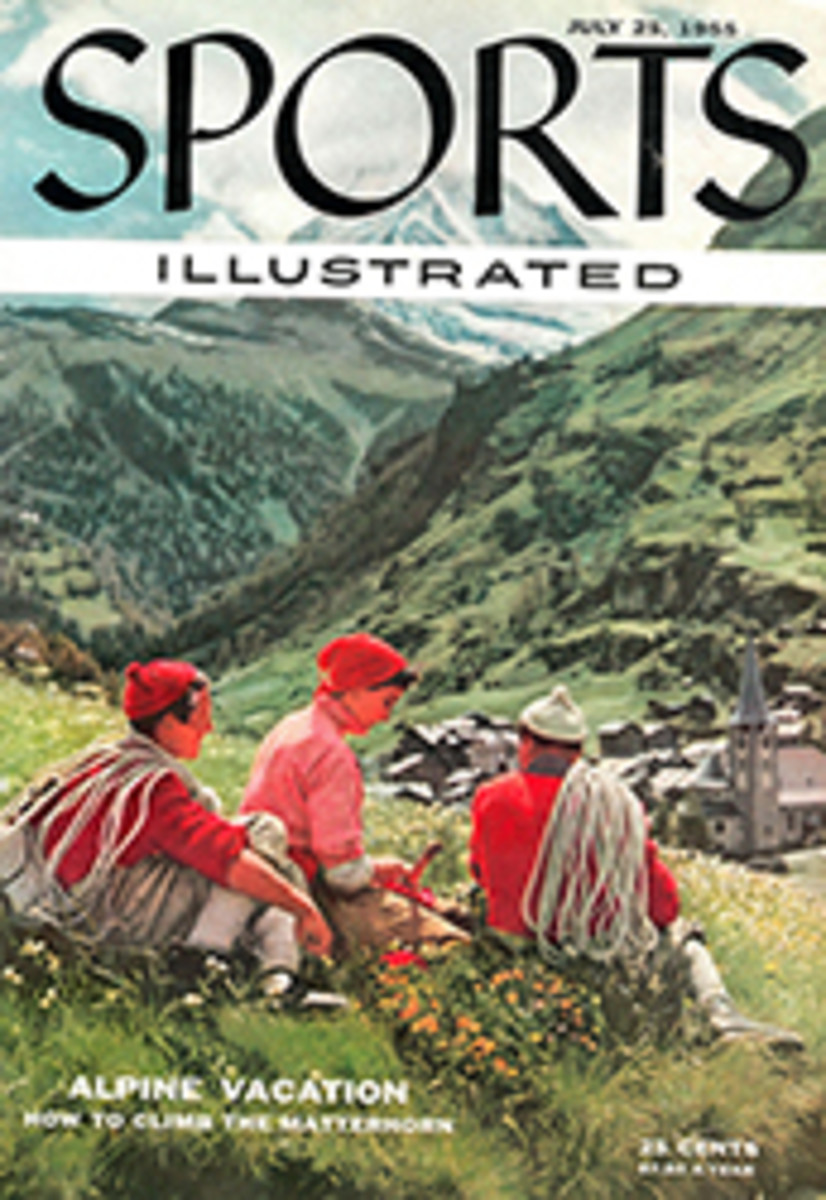
MOUNTAINEER'S MECCA: THE MATTERHORN
Zermatt is a street at the bottom of a valley floor. Some will see it as a greening valley of picturesque and beautiful Swiss scenery. Others as a street of challenge.
At one end of the street is the railroad station, the only way into the valley unless you board a mule. There are no cars because there is no road. And there is little likelihood of a road as long as the will of the Le Chemin-de-fer de Brigue-Viège and Zermatt be done. The B-V and Z has a railroad monopoly. It operates 28 miles of track which are level for the first seven miles, then rise 3,300 feet in the 21-mile stretch between Visp (or Viège) and Zermatt.
Leaning over the street like an overbearing personality is the lean, bare, bony, skyscraping, knee-melting bulk of the Matterhorn, a 14,780-foot rock pyramid that has brought a lingering death from exhaustion to a score who have climbed it too fast, killed well over a hundred climbers outright, including four of the seven who first breached its summit. Less than a hundred years ago mountain peasants hadn't a doubt that it was the world's highest mountain, the home of the spirits who dwelled in the ruins of some metaphysical city at the top of its wave-shaped peak.
Green meadows carpet the sloping valley sides, wall to wall. In season they take on patterns from the Alpine flowers that grow, blue and white and orange, among the reeds of deep green grass. A rushing river, the Mattervisp, trundles north through the village en route to the Rhone, which hurries into the east end of Lake Geneva, then eddies out the west end and surges underground through the Jura until it reappears in France, courses through Lyons and spills finally into the Mediterranean near Marseilles.
Down in the crease of the valley, left and right along the street, are the larchwood chalets toasted tan by the Alpine sun. Tucked away among them are some 2,425 beds set aside for visitors, far more than Zermatt needs to accommodate its own population, which is 1,148.
But although barmaids have done it, a 12-year-old girl did it, an 82-year-old Swiss achieved it, a cat managed it and 1,200 climbers make it every year, you don't have to climb the Matterhorn to enjoy Zermatt. The first hotel was opened by Alexander Seiler, a Swiss soap salesman, in 1855, 10 years before the mountain was conquered and in an era when its eventual ascent was deemed an impossibility. Seiler had come to visit his brother, the Abbé, but he came away notably impressed with the tourists who visited the valley to pick mountain flowers and net butterflies, two of the more titillating endeavors of the day.
Seiler stayed for 60 years, became a close friend and confidant of the pioneers, a friend of the guides, a mourner of the Matterhorn's dead. Today the Seiler interests own six hotels in and around the crags of the valley, comprising 665 beds. The chain is threatened only by the municipality of Zermatt which itself owns seven hotels and inns with 310 beds. Star of the Seiler chain is the Mont Cervin, a gem of paneled décor and advanced plumbing right in the center of town. It charges about $10 for a room with a view, a private bath and three meals a day. Seller's Villa Margherita is small and exclusive, its Victoria old and Victorian, and its Monte Rosa, which dates from the first climbing days and adjoins Abbé Seller's original house, a favorite with climbers.
Like the commune, the Seilers operate a few small inns pasted up among the neighboring mountains which can be reached on foot or by daily mule train. One exception is the Riffelalp at 7,307 feet, which can also be reached by mountain railway, then by an Alpine tram which has one red car.
Among the commune's hotels located at the comparatively sane altitude of 5,315 feet, which is to say the mid-town level of Zermatt, is the large and elegant Zermatterhof and the eminently chalet-Swiss Walliserhof. I like to think of the Zermatterhof as elegant because I bear an indelible picture of its soignée blue carriage filled with guests, newly acquired at the railroad station, careening through town, its tail-coated concierge standing on the lower step, hanging onto a pair of brass rails at the back door, supremely oblivious of a large herd of goats ambling and tinkling its way up the town's single street.
No matter where you stay at night you will almost surely be able to come by the fruits of the Valais, a Swiss canton nearly one-fifth covered by glacial ice. On real estate not frosted over, the Valaisans produce some eminent wines, among them Montibeux and Fendant. On the soil that's left they grow apricots and strawberries, dispatching a planeload of berries to England daily during the season.
At the slightest excuse, and sometimes with none at all, they will whip up a raclette, a dish made from a block of dry and aged Valaisan cheese you would think fire wouldn't melt. But it does, all right, and the melted part is stripped from the block, doused in red pepper and served with boiled potatoes. The idea of the red pepper, I have come with hard experience to discover, is to increase the consumption of Valais wines. A man with a raclette on his plate, another waiting in the oven and a dedicated Valaisan at his elbow to shill, will shortly discover not only the potatoes are boiled.
As for the daylight hours, those who would merely gasp at a mountain from awe rather than exertion can take the Blauherd chair lift, a two-seater conveyance which will lift you sideways over the forests to the Sunnegga restaurant at the 7,500-foot level. Walks stretch in all directions.
One of the best trips in the Alps is the open-air Gornergrat Railway which from mid-December to early October ratchets its way in about half an hour to the 10,300-foot level. From the terrace of the small hotel, with its brightly colored chairs, tables and umbrellas, there is a fantastic, almost unreal view of the great peaks, the Monte Rosa, the Breithorn, the Dent Blanche and the Matterhorn itself lofting their rocky heads from the white glacial seas.
For those who remain in Zermatt long enough for the Matterhorn to become a challenge, there are about a hundred accredited guides in Zermatt, and the price for conveying you up (and, preferably, back) over the usual route is about $35.
Climbers usually depart about noon of the first day, walk to the hut on the mountain shoulder in about five hours, then stay in the hut overnight—a matter of $5 for you and $2 for your guide. You spring for both. At dawn you head for the rocks, remembering the official brochure disseminated by the Swiss: "The Matterhorn is a favorite of mountain climbers...stone slides, icy mountain slopes, storms, thunder and lightning increase the dangers of ascent considerably."
It takes from four to five hours to reach the summit, another four or five hours to return. Filled with aches and elation, you will be reaching for a drink in Zermatt in the early evening hours of the second day.
Although 2,500 climbers scaled the Matterhorn in 1947, the peak's peak year, no one seriously considered climbing the mountain before 1860. Fifteen tries were recorded in the four years that followed, most of them from the Italian side. One of the climbers was an English artist named Edward Whymper who, up to 1860, had never really seen a sizable mountain. Commissioned by a London publisher to make sketches of some Alpine climbs, he caught the fever.
Half the recorded tries between 1861 and 1865 were made by him. On one exploratory trip he slipped on the Matterhorn. Later he was able to say this about it: "I whirled downwards in a series of bounds...now over ice, now into rocks, each striking my head four or five times with increased force. The last bound sent me spinning through the air in a leap of 50 or 60 feet...I struck the rocks, luckily, with the whole of my left side. They caught my clothes for a moment, and I fell back into the snow with motion arrested...the crash of the rocks—which I had started—as they fell into the glacier told how narrow had been the escape. As it was, I fell nearly 200 feet in seven or eight bounds. The rocks could not be let go of for a moment and the blood was spurting out of more than 20 cuts...and I vainly tried to close them with one hand, whilst holding on with the other. It was useless; the blood jerked out in blinding jets at each pulsation. At last, in a moment of inspiration, I kicked out a big lump of snow, and stuck it as a plaster on my head...then scrambling up, I got...to a place of safety and fainted dead away."
A week later Whymper was back on the mountain. And on July 13, 1865 Whymper and a party of six climbed the Matterhorn. Their success ended in disaster when four of the seven fell to their death during the descent in one of the most famous of mountaineering tragedies.
For the thousand or more climbers who follow Whymper's pioneering footsteps every year, down in the green valley of Zermatt—one out of four a woman, one out of many a child, one out of all an octogenarian—there are no trophies. The commune issues no certificates. For the climbers there is only that sense of inner satisfaction. And continued life.
PHOTO
TONI FRISSELL
THE MATTERHORN, a plume of clouds blowing from its crest, is scanned carefully by Guide Max Julen the day before a climb. Four of seven Julen brothers are guides.
PHOTO
TONI FRISSELL
AN ALPINE MEADOW, filled with flowers, greets Marylee Davey and Max and Emil Julen as they start off for a day's practice outing. Their ropes are of American-made nylon.
PHOTO
TONI FRISSELL
A GOOD-WEATHER PRAYER opens the mountain-climbing season in the shadow of the Matterhorn. Villagers from Zermatt and pilgrims from around the world, make a two-hour climb to the Catholic church at Findelen, praying all the way for good weather and safe climbing for the 200,000 tourists who come each year. Contrary to the best interests of the tourist industry, farmers climb to a church at Platten to pray for rain.
PHOTO
TONI FRISSELL
A LIMBERING-UP CLIMB on the 9,600-foot Riffelhorn, a "practice" mountain south of Zermatt, takes Guide Max Julen and Marylee Davey of Wakefield, R.I., on rock wall 1,200 feet above the Gorner Glacier. Matterhorn hopefuls usually work out on less difficult ascensions for a week before the big climb.
PHOTO
TONI FRISSELL
IN EUROPE'S HIGHEST HAYFIELD, above Zermatt, Marylee takes it easy after climbing the Matterhorn. She bought her neatly tapered pin-stripe slacks in Nice, wears them with American sneakers, checked shirt and ski parka. Zermatt hay is more desirable than that from lower meadows and each year the entire village turns out to bring it down. Guides carry piles weighing more than 100 pounds to build up their muscles.
PHOTO
TONI FRISSELL
A HORSEDRAWN TAXI brings visitors from the railway station to the Mont Cervin, Zermatt's oldest hotel. There are no cars in Zermatt because there are no roads.
PHOTO
TONI FRISSELL
CONGRATULATIONS on scaling Matterhorn are given Oscar Kolb by guide.
PHOTO
TONI FRISSELL
SILHOUETTED AGAINST A GLACIER, MARYLEE DAVEY AND HER TWO GUIDES CLIMB RIFFELHORN
PHOTO
TONI FRISSELL
EXHAUSTION gives way to elation as Oklahoman Forrest Darrough ends climb.
PHOTO
TONI FRISSELL
HANDCLASP from Max Julen at the end of her ascent makes Marylee Davey smile.
PHOTO
TONI FRISSELL
PAT ON THE BACK comes to Pfc. Arlin Knight who climbed mountain in 5½ hours.

